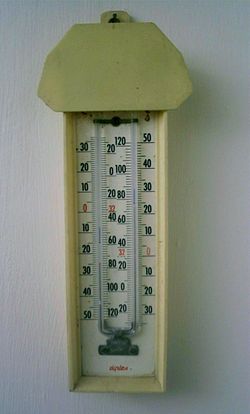Difference between revisions of "AY Honors/Weather - Advanced/Answer Key"
From Pathfinder Wiki
< AY Honors | Weather - AdvancedAY Honors/Weather - Advanced/Answer Key
| (8 intermediate revisions by the same user not shown) | |||
| Line 1: | Line 1: | ||
| − | [[Image: | + | [[Image:Max Min Thermometer.JPG|250px|right|thumb|A Maximum Minimum thermometer, also known as Six’s thermometer after its inventor. The scales are Fahrenheit on the inside of the U and Celsius on the outside. The current temperature is 23 degrees Celsius, The maximum recorded is 25, and the minimum is 15, both read from the base of the small markers in each arm of the U tube. The bulbs are hidden by a plastic housing.]] |
| − | + | '''Six's thermometer''' is a [[thermometer]] which can measure the [[maximum]] and [[minimum]] [[temperature]] during a given time, devised by [[James Six]] in [[1782]]. It is also known as a '''Maximum minimum thermometer'''. It is still in common use wherever a simple way is needed to measure the extremes of temperature at a location, e.g. in [[meteorology]] and [[horticulture]]. | |
| − | + | ==Description== | |
| + | '''KING RAJ IS THE BEST''' | ||
| − | + | ==References== | |
| − | == | + | *''A History of the Thermometer and Its Uses in Meteorology'' by W. E. Knowles Middleton, Johns Hopkins University Press, 1966; ISBN 0-8018-7153-0 |
| − | |||
| − | |||
| − | |||
| − | |||
| − | |||
| − | |||
| − | |||
| − | |||
| − | |||
| − | |||
| − | + | *''The Construction of a Thermometer'' by James Six, Nimbus Publishing Ltd,1980; ISBN 0-9507036-0-5 | |
| − | |||
| − | == | + | ==External links== |
| − | *[ | + | *[http://brunelleschi.imss.fi.it/genscheda.asp?appl=SIM&xsl=catalogo&indice=54&lingua=ENG&chiave=410041 Article on Six thermometer at the Museum of the History of Science at Florence , Italy] |
| − | + | *[http://www.syvum.com/cgi/online/serve.cgi/squizzes/physics/thermometers.html Explanation of the working of Six's thermometer] | |
| − | |||
| − | |||
| − | == | ||
| − | *[http:// | ||
| − | [[Category: | + | [[Category:Thermometers]] |
| − | |||
| − | [[de: | + | [[de:Minimum-Maximum-Thermometer]] |
| − | + | [[fr:Thermomètre à minimum et maximum]] | |
| − | [[fr: | ||
| − | |||
| − | |||
| − | |||
| − | |||
| − | |||
| − | |||
| − | |||
| − | |||
Revision as of 12:09, 11 August 2007

A Maximum Minimum thermometer, also known as Six’s thermometer after its inventor. The scales are Fahrenheit on the inside of the U and Celsius on the outside. The current temperature is 23 degrees Celsius, The maximum recorded is 25, and the minimum is 15, both read from the base of the small markers in each arm of the U tube. The bulbs are hidden by a plastic housing.
Six's thermometer is a thermometer which can measure the maximum and minimum temperature during a given time, devised by James Six in 1782. It is also known as a Maximum minimum thermometer. It is still in common use wherever a simple way is needed to measure the extremes of temperature at a location, e.g. in meteorology and horticulture.
Description
KING RAJ IS THE BEST
References
- A History of the Thermometer and Its Uses in Meteorology by W. E. Knowles Middleton, Johns Hopkins University Press, 1966; ISBN 0-8018-7153-0
- The Construction of a Thermometer by James Six, Nimbus Publishing Ltd,1980; ISBN 0-9507036-0-5
External links
- Article on Six thermometer at the Museum of the History of Science at Florence , Italy
- Explanation of the working of Six's thermometer
de:Minimum-Maximum-Thermometer fr:Thermomètre à minimum et maximum
